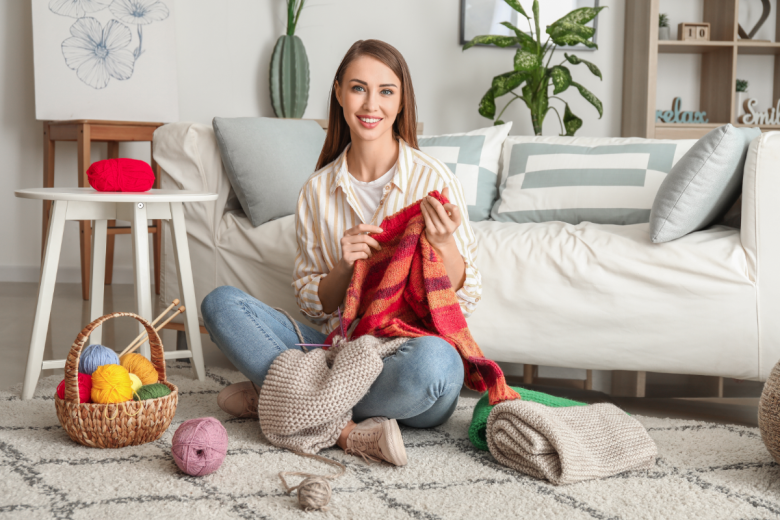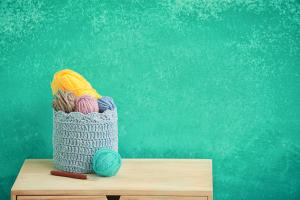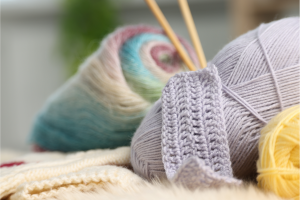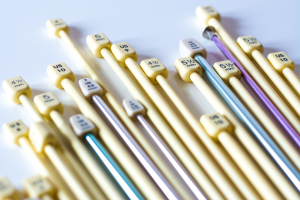When it comes to knitting projects, the finishing touches can make all the difference. While the design and craftsmanship of a piece are important, it’s the finishing that elevates the project, giving it a polished, professional look. Whether you’re creating a cozy sweater, a delicate shawl, or a pair of mittens, perfecting the finishes can transform your knitted items from good to extraordinary.
The Importance of Finishing in Knitting Projects
Finishing techniques in knitting go far beyond simply tying off loose ends. They include methods for seamlessly joining pieces, smoothing edges, and creating smooth hems and cuffs. Proper finishing not only enhances the overall appearance of your piece but also affects its functionality. For example, well-stitched seams provide a comfortable fit and ensure that the garment holds up over time, while a clean edge prevents unraveling and fraying.
Good finishes can also add sophistication, showcasing your knitting skills and making your work look like it came from a high-end boutique rather than a handmade hobby project. As a knitter, learning to master these techniques can be the key to creating professional-looking pieces that rival store-bought items.
How Finishing Affects the Final Outcome
The quality of your finishing can significantly impact the overall result of your knitting project. Even the most beautifully knit fabric can look unfinished or sloppy if the edges are left raw, seams are visible, or the finishing techniques aren’t carefully executed. On the other hand, meticulous attention to detail in the finishing process will ensure that the final piece is neat, cohesive, and well-structured.
In knitting, the “perfect finish” isn’t just about making the project look nice—it’s also about functionality. Well-executed finishes improve the durability and wearability of your items. They can make the difference between a garment that lasts for years and one that falls apart after just a few washes.
As we explore the different techniques and tips for perfecting your finishes, remember that these steps are just as important as the knitting itself. With the right approach, you can take your knitting projects to the next level, ensuring that they look as good as they feel.
In fact, mastering the art of finishing is often what separates an experienced knitter from a beginner. While many knitters focus on the stitches and patterns during the making process, it’s the finishing touches that require a more nuanced understanding of technique. The finishing phase is where all the effort you’ve put into creating the design truly shines. It’s your opportunity to correct any imperfections, smooth out edges, and refine the overall look of the piece, ensuring that your hard work is displayed at its best.
Finishing also plays a critical role in the longevity of your knitted items. Properly woven-in ends and securely sewn seams can prevent the fabric from stretching or unraveling over time. This is particularly important for items that will undergo frequent use, such as scarves, sweaters, and blankets. Additionally, taking the time to finish your project carefully ensures that the final piece will hold its shape and integrity, maintaining its original appearance after multiple wears or washes.
Another key benefit of focusing on finishing is the ability to add your personal touch to the item. Whether it’s adding a decorative button, a lace edging, or a custom label, these finishing elements give you the freedom to create something truly unique. It’s a chance to personalize your knitting projects, making them one-of-a-kind pieces that reflect your style and creativity.
As we delve deeper into the various finishing techniques, remember that this is not just a step in the process but an opportunity to elevate your work. Embracing the importance of finishing can turn a simple knitting project into a masterpiece, one that you can proudly wear or gift to others with the knowledge that it has been completed to the highest standard.
Choosing the Right Materials for Knitting Finishes
The materials you choose for your knitting project play a significant role in the quality of the finish. While the yarn you use for the main project is important, the finishing materials—such as the type of thread for sewing seams or the needles for binding off—are equally crucial. For example, using a smooth, high-quality yarn for the seams can make a noticeable difference in how neat and professional the finish looks. If you’re working with wool, choose a similar yarn for seams to ensure it blends seamlessly. Additionally, using a yarn needle with a large eye is essential for threading thick yarn without splitting it. The right materials ensure that your finishes complement the overall look of your project and enhance its longevity.
Techniques for Closing Stitches: Achieving Clean Finishes
One of the first steps in achieving a perfect finish is mastering the technique of closing stitches properly. The way you bind off stitches can affect the elasticity, appearance, and overall neatness of your piece. There are several methods of binding off, including the standard bind-off, the stretchy bind-off, and the invisible bind-off. For most projects, the standard bind-off works well, but for garments like socks, sweaters, or lace items, a stretchy bind-off ensures that the edges remain flexible. The key to a clean finish is making sure your bind-off isn’t too tight or too loose—both can lead to an uneven edge that detracts from the look of your project. Practice different techniques and choose the one that works best for your specific project.
How to Seam and Join Knit Pieces Perfectly
When working on projects that involve multiple pieces—such as sweaters or blankets—seaming is an important step in creating a flawless finish. The way you join knitted sections can make or break the look of your project. There are a variety of techniques to consider, including the mattress stitch, whip stitch, and the Kitchener stitch for seamless joins. The mattress stitch is commonly used for joining stockinette stitch pieces, as it creates nearly invisible seams that blend into the fabric. For a perfect seam, always make sure the edges of the pieces are aligned properly, and use a contrasting color for the thread to help you see the stitches before you finalize your join.
Neckline and Cuff Finishing: Elevating Your Pieces with Style
The neckline and cuffs of knitted garments are often the areas that benefit the most from careful finishing. These areas need to be not only functional but also stylish. A neat, well-executed neckline can give your sweater or cardigan a tailored look, while clean cuffs can add sophistication to your project. For necklines, consider techniques like picking up stitches to knit a neat ribbed edge or creating a rolled hem for a relaxed look. When finishing cuffs, it’s important to use a stretchy bind-off to ensure the cuffs fit comfortably without being too tight or loose. These subtle details make all the difference in the overall appearance of your garment.
How to Use the Invisible Bind-Off for a Perfect Finish
The invisible bind-off is one of the best-kept secrets for achieving a seamless, professional-looking edge. This technique is especially useful for projects like lace shawls, where the edge should look as though it was naturally knitted. The invisible bind-off is worked by using a tapestry needle and weaving through the stitches in a way that hides the bind-off edge entirely. This technique creates an almost imperceptible finish, leaving the edge looking as if it has no visible stitches at all. To achieve this, you’ll need to carefully pull the yarn taut to avoid any gaps, making sure that the bind-off is smooth and even throughout the piece.
The Final Touch: Blocking Knitting for Professional Results
Blocking is one of the most important steps in finishing a knitting project. It’s the process of wetting or steaming your knitted fabric and then shaping it into its final dimensions. Blocking helps to open up lacework, smooth out uneven stitches, and give your piece the proper shape. For items like shawls or lace garments, blocking can transform the final look, making the stitches more defined and the overall design more striking. To block your work, gently soak the piece in lukewarm water, pin it to a blocking board, and allow it to dry completely. The result will be a piece that looks polished, with crisp edges and perfectly laid-out stitches.
Tips for Hiding Loose Ends and Extra Threads
One of the final steps in finishing your knitted project is hiding any loose ends and extra threads that may be sticking out. The key to achieving a flawless finish is making sure that no yarn tails are visible on the inside or outside of your work. Use a tapestry needle to weave in ends, working the yarn through the stitches in a way that doesn’t disrupt the pattern. For projects with multiple colors, be sure to carry the yarn across the back of the work, securing it as you go. To ensure that the ends stay in place and do not unravel over time, weave them in a few rows and trim excess yarn carefully. This simple step can make a huge difference in the final look of your project, giving it a neat, clean appearance.
By paying close attention to these finishing techniques, you can transform your knitted projects into professional-looking works of art. The right materials, finishing methods, and attention to detail will ensure that your creations are not only beautiful but also durable and wearable for years to come.
How Finishing Contributes to the Durability and Appearance of Your Pieces
The finishing techniques you use in your knitting projects are just as important as the knitting itself. While the yarn and pattern choices are crucial, it’s the finishing touches that determine the overall quality of your finished item. Well-executed finishes not only enhance the appearance, making your pieces look polished and professional, but they also contribute to the durability and longevity of your work. Properly sewn seams, neatly bound edges, and securely woven-in ends ensure that your project won’t unravel or fall apart with use. In garments like sweaters or scarves, finishing details like cuffs, necklines, and hems help maintain shape and provide comfort, making the difference between a wearable item and one that starts to deteriorate quickly. Ultimately, good finishing adds both aesthetic value and practical functionality to your knitted pieces, allowing them to withstand wear and tear while maintaining their beauty.
Learning and Practice: The Path to Perfection in Knitting
Mastering the art of knitting finishes is a journey that requires patience, practice, and attention to detail. It’s not enough to simply know the techniques—you must also develop the skill and finesse to execute them seamlessly. The more you practice different finishing methods, such as seaming, binding off, and weaving in ends, the more comfortable you’ll become with them, and the higher the quality of your finished projects will be. Remember, even seasoned knitters improve their skills over time, so don’t be discouraged if your first few attempts aren’t perfect. With each project, you’ll gain confidence, and your finishes will become smoother and more refined.
The path to perfect knitting finishes is ultimately a combination of learning the techniques, applying them with care, and continually improving your craft. By dedicating time to mastering these details, you’ll elevate your knitting projects, creating pieces that not only look stunning but also stand the test of time. So, take pride in your finishes—they’re the final touch that transforms your handmade items into beautiful, functional works of art.
Additionally, finishing techniques also allow knitters to express their personal style and creativity. Whether it’s adding a unique border, experimenting with different seam finishes, or incorporating decorative elements like embroidery or beads, the finishing phase opens up a world of possibilities. These subtle touches can completely change the character of a piece, giving it a signature flair that reflects the knitter’s individuality. Even simple adjustments, such as adding a contrasting color to the edges or using a textured stitch for the seams, can make a significant impact, transforming a basic design into something extraordinary.
Furthermore, the importance of finishing extends beyond the aesthetics and functionality—it also speaks to the craftsmanship and dedication that goes into every handmade piece. A well-finished project shows the time and care invested by the knitter, setting it apart from mass-produced items. In a world where fast fashion often dominates, a well-finished knitted item is a testament to sustainable, mindful crafting. By ensuring that every aspect of your knitting, from the first stitch to the last detail, is executed with precision, you contribute to the growing appreciation for handmade, high-quality goods.
In conclusion, finishing is an essential component of knitting that should never be overlooked. It is what elevates a project from good to great, ensuring that your hard work is displayed in the best light while ensuring its longevity. As you continue to refine your finishing techniques, you’ll notice not only an improvement in the durability and appearance of your pieces but also an increased sense of satisfaction in your craft. The art of knitting is a constant learning experience, and with each finished project, you’re taking one step closer to mastery.




